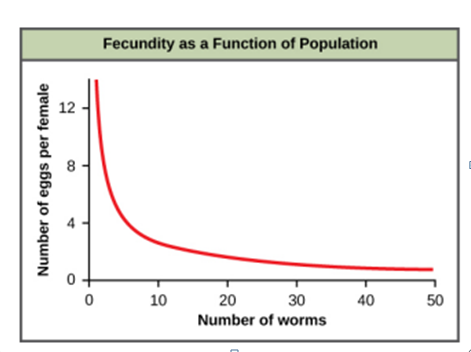Aquatic arthropods that fragment organic particles and also eat bacteria and fungi on the surface of the litter are called
A) shredders.
B) filtering collectors.
C) gathering collectors.
D) grazers.
A
You might also like to view...
Why don't ants that protect the Acacia tree scare off bees trying to pollinate the tree's flowers?
A. They can't climb to the tops of the tree. B. The bees are too big. C. The bees fly in and out quickly. D. The open flowers contain a chemical that is an ant deterrent. E. Parasitoid wasps protect the bees from attack.
An example of density-dependent regulation is shown in this graph with results from a study focusing on the giant intestinal roundworm (Ascaris lumbricoides), a parasite of humans and other mammals. Denser populations of the parasite contained fewer eggs. One possible explanation for this is that females would be smaller in more dense populations (due to limited resources) and that smaller females would have fewer eggs. This hypothesis was tested and disproved in a 2009 study which showed that female weight had no influence. Given that each female was producing fewer eggs, why was the population continuing to grow?

a. More worms were moving in from adjacent populations.
b. The population was expanding due to increased mating.
c. With lower population densities, mortality decreased.
d. Lifespans were extending due to lower egg production.
The most complex wayfinding mechanism is ____, in which animals use both a compass and a mental
map of the area.
a. piloting b. orienteering c. compass orientation d. migration e. navigation
Which of the following experimental techniques involves treating a genetic disorder by replacing a defective gene with a functional gene?
A.) genetic screening B.) bioinformatics C.) genomics D.) gene therapy